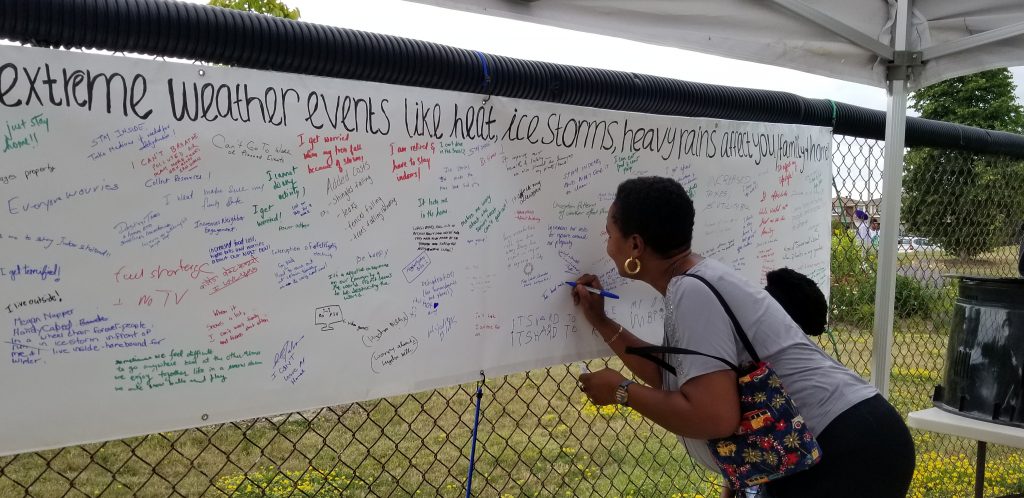Climate Ready County Court is a neighbourhood-scale vulnerability assessment and adaption plan co-created by residents and stakeholders to prepare for local climate change impacts and set the stage for collaborative action.

About the Plan
Building on the strength of the County Court SNAP, Climate Ready County Court is one of the first vulnerability assessment and adaptation plans to be done at the neighbourhood scale in Canada.
Climate Ready County Court seeks to create understanding of local climate-related risks and vulnerabilities, and to identify adaptation strategies to avoid or mitigate potential impacts
The plan addresses short-term and long-term resilience by pulling together strategies for built and natural infrastructure, as well as emergency preparedness and community resilience.
The plan sets the stage for collaborative efforts to drive actions on climate change adaptation within the County Court neighbourhood, as well as in City of Brampton and across Region of Peel.

The Key Objectives
- To combine local knowledge with broader City of Brampton and Region of Peel vulnerability assessments and sector-based studies
- To create a personal connection to local climate futures and create a shared plan using creative, inspiring, and future-oriented activities
- To support capacity-building among local residents and the County Court Neighbourhood Association (CCNA)
- To inform the final stages of SNAP implementation and refinement of municipal implementation priorities
- To serve as a framework to support neighbourhood-based adaptation planning as a component of TRCA’s SNAP program and beyond
The Process and Timeline
| PHASE 1 | Fall 2018 to Winter 2019 | SYSTEM CHARACTERIZATION
(Broad stakeholder input solicited) |
| PHASE 2 | Spring 2019 | ANALYSIS OF CLIMATE IMPACT AND VULNERABILITY FACTORS
|
| PHASE 3 | Summer 2019 | DEVELOPMENT OF ADAPTATION STRATEGIES & PROJECTS
(Broad stakeholder input solicited) |
| PHASE 4 | Fall 2019 | EVALUATION AND FINAL REPORT
|




What Are the Local Risks and Vulnerabilities?
- Increasing Heat Stress: Most of the County Court neighbourhood is vulnerable to the urban heat island effect, particularly areas with paved surfaces.
- Low Tree Canopy Coverage: The County Court neighbourhood has a large variety of natural spaces, but tree canopy is limited. In addition, a lack of tree diversity creates higher risk of tree canopy loss through pest infestation or natural disaster. Improving the neighbourhood tree canopy can help mediate some of the impacts of climate change.
- Risk to Homes: Extreme wind events may cause physical damage to homes in the future. Increased use of air conditioning may also lead to more frequent power outages.
- Lack of Awareness: Residents in the County Court neighbourhood would benefit from increased awareness around climate change and emergency preparedness activities.
- Communication Barriers: With a small but significant percentage of non-English-speaking residents (approximately 4-8%), as well as a sizeable number of seniors and people living alone, communication can be difficult.
- Increasing Isolation: Isolated pockets within the neighbourhood may become further isolated during extreme weather events and must shelter in place.
- Limited Mobility: Limited trails and pathways around the eastern portion of the neighbourhood may cause additional isolation for residents in that area.
What Are the Key Adaptation Strategies?
- Splash pads and water fountains
- Public tree planting and shade structures
- Central hubs and gathering areas
- Know your neighbour program
- Neighbourhood emergency plan
- Consider integrating designated heating/cooling
- Integrated design of public realm
- Consider establishing a multi-unit residential community garden
- Leverage existing groups to increase engagement
- Consider using faith-based programming
- Energy conservation measures
- Developing a climate resiliency checklist
- Green roofs and white roofs
Creating Adaptation Designs
To complement the final adaptation strategies, the project team created a set of adaptation designs to help visualize what these opportunities may look like, and to showcase the co-benefits and synergies in the landscape.
View the report using the document reader below. Select Read Now for a full-screen view; select the arrow to the right to advance to the next page.
To learn more about Climate Ready County Court, please contact:
For more information, please contact:
Shannon Logan, Senior Program Manager, Sustainable Neighbourhoods
Education and Training Division
shannon.logan@trca.ca
(437) 880-2412
